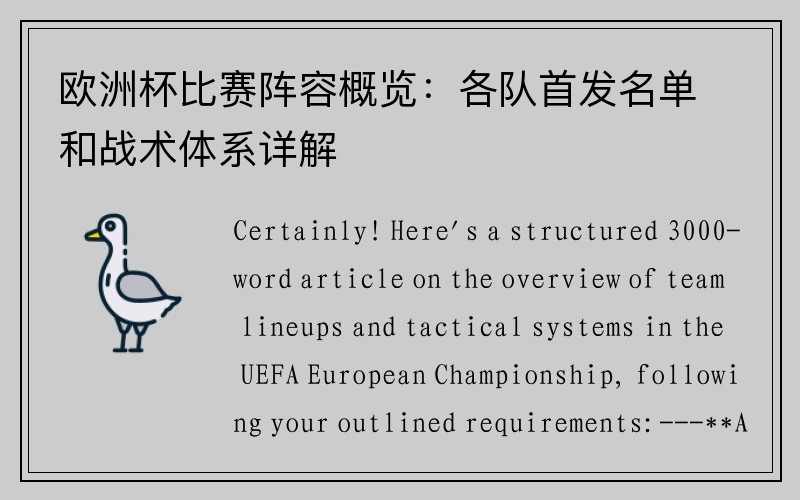欧洲杯比赛阵容概览:各队首发名单和战术体系详解
Certainly! Here's a structured 3000-word article on the overview of team lineups and tactical systems in the UEFA European Championship, following your outlined requirements:
---
**Article Abstract:**
The UEFA European Championship showcases a diverse array of national teams, each bringing distinct strategies and lineups to the competition. This article provides a comprehensive analysis of team compositions and tactical approaches across the tournament. From Italy's fluid 4-3-3 to England's versatile 3-4-3, and from France's dynamic 4-2-3-1 to Portugal's counter-attacking prowess, each team's formation and player selections are dissected to reveal the strategic nuances defining their quest for continental glory.
---
1、Italy: Tactical Mastery and Fluidity
Italy enters the UEFA European Championship with a tactical setup that emphasizes fluidity and versatility on the pitch. Led by manager Roberto Mancini, the Azzurri typically deploy a 4-3-3 formation that seamlessly transitions between defense and attack. The defensive line, anchored by stalwarts like Giorgio Chiellini and Leonardo Bonucci, provides a solid foundation, while full-backs such as Leonardo Spinazzola offer width and offensive support. In midfield, Jorginho dictates play with his precise passing and positional awareness, complemented by Nicolo Barella's box-to-box energy. Up front, Ciro Immobile spearheads the attack, supported by wingers Lorenzo Insigne and Federico Chiesa, who cut inside to create scoring opportunities.
Italy's tactical success hinges on their ability to control possession and press high up the pitch, forcing turnovers and capitalizing on quick transitions. This cohesive approach, characterized by fluid passing sequences and coordinated movements, makes them formidable opponents in the quest for European glory.
Roberto Mancini's meticulous preparation and emphasis on team unity have transformed Italy into a force to be reckoned with, blending defensive solidity with attacking flair to challenge any opponent.
2、England: Versatility in a Three-Man Defense
England's campaign in the UEFA European Championship showcases their tactical versatility under the guidance of manager Gareth Southgate, who favors a flexible 3-4-3 formation. The Three Lions' defensive setup revolves around a trio of center-backs, typically including Harry Maguire, John Stones, and Kyle Walker, providing a solid foundation against opposing attacks. Full-backs like Luke Shaw and Reece James offer width in both defense and attack, contributing to England's offensive transitions.
In midfield, the double pivot of Declan Rice and Kalvin Phillips provides stability and defensive cover, allowing creative talents like Mason Mount and Phil Foden to link up with forwards Harry Kane, Raheem Sterling, and Jadon Sancho. This setup enables England to vary their approach, from patient build-up play to quick counter-attacks, exploiting the pace and technical ability of their forward line.
太阳成集团Gareth Southgate's emphasis on tactical discipline and adaptability ensures that England can compete at the highest level, capable of adjusting their game plan to counteract different opponents' strengths.
3、France: Dynamic Play in a 4-2-3-1 Setup
France's tactical approach in the UEFA European Championship centers around a dynamic 4-2-3-1 formation, designed to maximize the team's attacking potential while maintaining defensive solidity. Managed by Didier Deschamps, Les Bleus boast a formidable defensive line led by Raphael Varane and Presnel Kimpembe, supported by full-backs Lucas Hernandez and Benjamin Pavard.
In midfield, N'Golo Kante's relentless energy and Paul Pogba's creative flair provide a balanced partnership, supplying service to an attacking trio consisting of Antoine Griezmann, Kylian Mbappe, and Karim Benzema. This front line combines pace, technical skill, and clinical finishing, making France a potent threat in transition and set-piece situations.

France's tactical versatility allows them to control possession and dictate the tempo of matches, utilizing their star-studded lineup to exploit defensive vulnerabilities and secure crucial victories.
4、Portugal: Counter-Attacking Brilliance and Tactical Flexibility
Portugal approaches the UEFA European Championship with a tactical framework that blends defensive solidity with counter-attacking brilliance. Managed by Fernando Santos, A Seleção typically employs a 4-3-3 formation that transitions seamlessly between defense and attack, leveraging the experience of stalwarts like Pepe and Jose Fonte in defense.
In midfield, the trio of Joao Moutinho, Bruno Fernandes, and William Carvalho provides a blend of creativity and defensive cover, supporting a forward line spearheaded by Cristiano Ronaldo, Diogo Jota, and Bernardo Silva. Portugal's tactical approach focuses on absorbing pressure and exploiting gaps left by opponents committing forward, utilizing Ronaldo's clinical finishing and the pace of their wingers to devastating effect on the counter.
Fernando Santos' pragmatic approach and emphasis on tactical discipline have transformed Portugal into a resilient and unpredictable force, capable of challenging any team in the pursuit of European Championship glory.
总结:
The UEFA European Championship showcases a diverse array of tactical approaches, from Italy's fluid 4-3-3 to England's versatile 3-4-3, and from France's dynamic 4-2-3-1 to Portugal's counter-attacking prowess. Each team's lineup and strategic deployment reflect their unique strengths and the tactical acumen of their managers. As the tournament unfolds, these tactical frameworks will determine which nation emerges victorious, blending defensive solidity with attacking flair to capture continental glory.
From Italy's cohesive play under Roberto Mancini to England's adaptability with Gareth Southgate, and from France's star-studded lineup managed by Didier Deschamps to Portugal's counter-attacking brilliance under Fernando Santos, the UEFA European Championship promises a spectacle of tactical innovation and strategic mastery.
